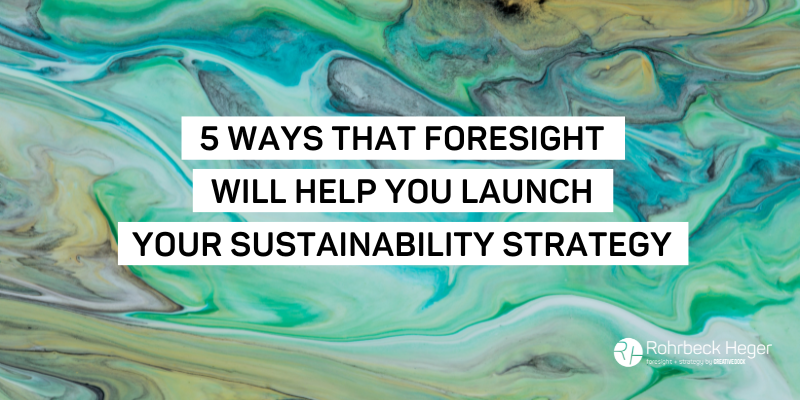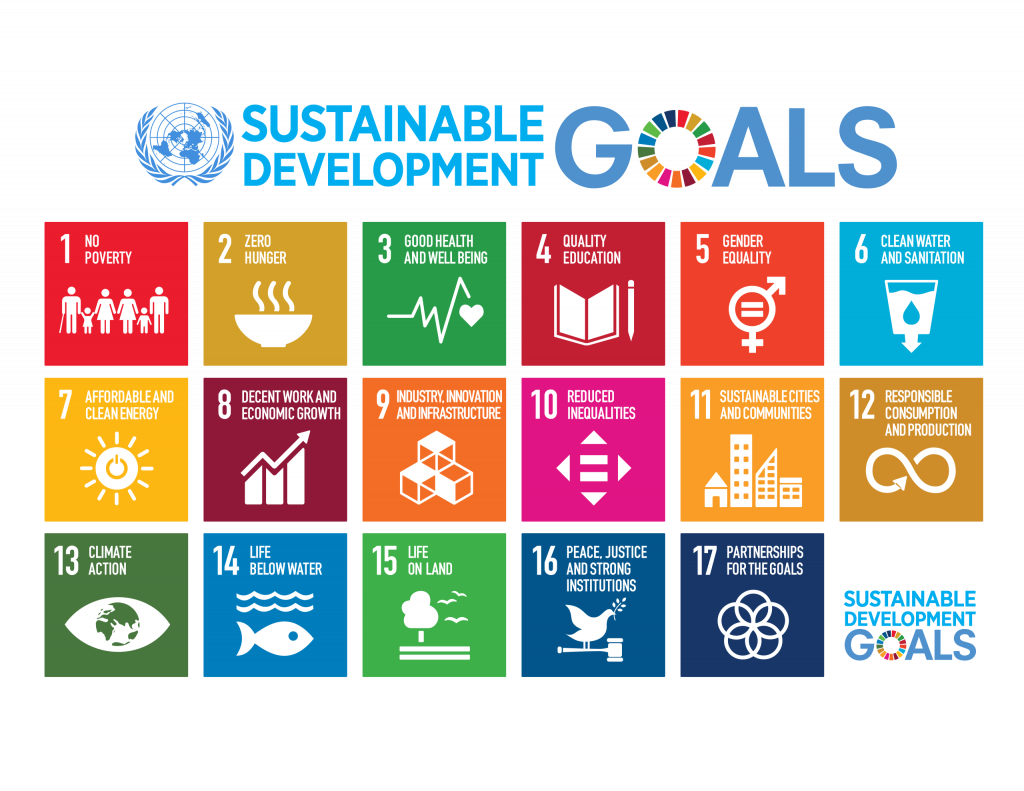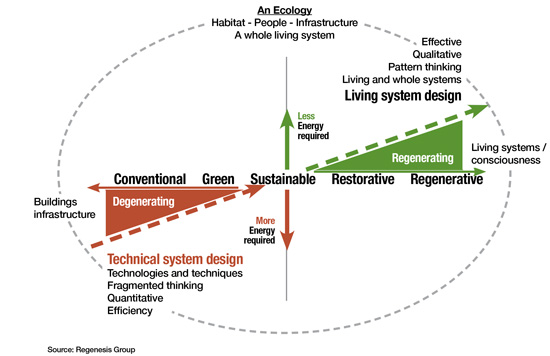
5 Ways That Foresight Will Help You Launch Your Sustainability Strategy
Sustainability is the new digitalization. Here’s how to use strategic foresight to pay attention, find the signals in the noise, and leverage this complex, systemic transformation to your advantage.
Key Takeaways:
- Sustainability, just as digitalization before it, will be transformative in every way. It is imperative that companies act early, quickly, and decisively to ride the wave of change to their advantage.
- Strategic Foresight is a practice that includes powerful tools to build a robust sustainability strategy, one that operates within global frameworks such as the United Nation’s 17 Sustainable Development Goals.
- With foresight you can:
- Capture and navigate complexity.
- Understand what’s next.
- Set the right priorities.
- Identify opportunities – and seize them!
- Train future-proof thinking and encourage collaboration.
By Dr. Sebastian Knab with Emily Phillips
If there’s one thing that’s certain about sustainability, it’s that the topic itself has morphed from a handful of ancillary talking points into the conversation of our day.
Just a few years back, when it came to building a business strategy, “sustainability” was one topic of many. Case in point: my team and I would find ourselves building future scenarios with clients. Among 100 factors, just 5-6 would relate to sustainability. Those we did identify back then were broad factors, such as “sustainability is important to consumers” or “regulators push sustainability.” Now, in stark contrast, sustainability has gone from a sideshow to the main act, headlining conferences, reports, and boardroom discussions. Corporates increasingly hire for a role devoted to this very topic: a new function, Chief Sustainability Officer, reports directly to the CEO.
Clients often tell me that they’ve been tasked with “doing something about sustainability.” But what, exactly, does that entail? And what’s the best approach to tackling this essential and complicated topic? Sustainability is the defining challenge of our age and frankly both our professional and personal legacies. To put it bluntly: if we want a future, we have to act sustainably. A strong match for navigating this critical topic, strategic foresight addresses complexity head-on and embraces uncertainty, so we can seize this moment before it passes us by.
Sustainability is the new digitalization
That sustainability is important, imperative, and non-negotiable is, at this point in time, a no-brainer. But what may not be so clear to all is that sustainability’s obviousness belies a true complexity, one that is far richer than, say, offsetting CO2 emissions. A comparison I like to make is to digitalization.
A decade ago, a lot of people had this idea that digitalization was a question of replacing paper with digital files. Hindsight is 20/20, and looking back we now know that actually, digitalization continues to fundamentally transform just about everything. Just a handful of years ago, it was difficult to imagine that this shift would disrupt not only the taxi industry but also television, finance, even election outcomes.
Just as digitalization minted a new generation of norm-shattering businesses, leaving many incumbents in the dust, so too is sustainability a rich landscape of opportunity, excitement — and peril.
It’s the same with sustainability. I firmly believe that the sustainability transformation is just as incredibly complex, enormous in scope, and multi-faceted as its digital counterpart. And just as digitalization minted a new generation of norm-shattering businesses, leaving many incumbents in the dust, so too is sustainability a rich landscape of opportunity, excitement — and peril. Nobody wanted to be outdone by a digital upstart, and it’s the same for sustainably-conceived business models. They are there for the taking, but only for those who stay ahead of the curve, and act early, quickly, and decisively.
So, how to stay ahead of the curve, act early, quickly, and decisively? That’s where my work, the practice of strategic foresight, comes into play. Here I’ve highlighted five ways that strategic foresight helps teams and organizations get a front-row seat to the sustainability transformation, benefit from a comprehensive understanding of the topics at hand, and develop actionable, impactful solutions.
As an added bonus, consider what hangs in the balance: a healthy, vibrant world that provides for the needs of us humans. After all, we need the world more than it needs us.
Manage your sustainability transformation in these 5 ways with strategic foresight:
1. Capture and navigate complexity.
Let’s begin with a fundamental question: what does sustainability actually mean? Despite being the buzzword du jour and sitting at the center of many debates around business strategy, a comprehensive definition of sustainability remains elusive. Doesn’t sustainability start and end with becoming a bit cleaner, generating less waste, introducing some more efficiencies? Spoiler alert: that doesn’t begin to cover it.
Sustainability, like digitalization before it, will be transformative in every way. Yes, having a plan in place to reduce CO2 emissions and achieve net-zero by 2030 are steps in the right direction. But sustainability is a great deal more than this. Strategic foresight, which seeks to understand not the status quo and current landscape, but rather how topics may evolve in the future, embraces and synthesizes sustainability’s many facets and its inherent complexity. A sustainable business strategy must consider the 17 Sustainable Development Goals, 9 Planetary Boundaries, the 9 Rs of the Circular Economy, and my personal favorite: Doughnut Economics.
Unfamiliar with these frameworks? You’re not alone. German business press Handelsblatt reports that only 40% of managers are familiar with the UN’s SDGs (Link in German.) A company can only call itself future-proof and ready to not only survive but thrive in the sustainability transformation if it understands the sheer breadth and depth of what sustainability actually entails.

2. Understand what’s next.
Once you understand that sustainability is more than just carbon and climate, it’s time to anticipate what’s next on the horizon. Net zero may be on everyone’s lips today, but tomorrow’s sustainability topics will be something else — net positive, biodiversity, ocean acidification, or elimination of single use plastics — there are many possibilities.
So how might things evolve? And what’s the next chapter in this story? How does it relate to you and your business? Foresight methodologies such as trend radars and scenario planning address these very questions and paint a fuller picture of the topics that are bound to arise and define the future. Whether it’s the SDGs or planetary boundaries, when you implement tools such as trend radars and future scenarios, you’ll be prepared for when these topics surface, rather than caught unaware.
3. Set the right priorities.
Identifying and tracking trends, building sustainability scenarios — these steps will often raise questions for a company in not just one or two, but several areas of their business. So which should you focus on? What planetary boundaries are your main issues? Which SDGs are you best positioned to contribute to?
One of the insights that reveals itself early on in the strategic foresight process is the sheer complexity of sustainability, and, frankly, a sense of overwhelm can set in. It’s a huge topic with many interrelations, but there’s only so much that any one company can address at once. Faced with a prioritization problem, strategic foresight can help make sense of the options and point you in the right direction. Not only this, but it helps you make your case and communicate your preferred path in a transparent, compelling, and well-grounded manner.
Foresight methodologies such as identifying innovation search fields help to prioritize what we call opportunity areas, essential to forming a future-forward strategy. What distinguishes foresight practice from say, materiality analysis or design thinking is that those two approaches address today’s world —today’s impacts, today’s consumer needs, today’s stakeholders. Foresight, on the other hand, turns its gaze towards the future, attempting to identify future impacts, future consumer needs, and future stakeholders.
Foresight asks not “what innovations are needed to solve these current issues?” but rather, “how does my innovation portfolio hold up when we stress test it within these imagined (and plausible) future worlds?” With the help of strategic foresight, innovation and strategy teams can prioritize with confidence and make sure their decisions result in impactful work for the longer term.
Sustainability is a space where if you move early, quickly, and decisively, you can contribute to solutions for pressing global challenges while simultaneously benefitting from the transformation at hand.
4. Identify opportunities – and seize them!
Once a strategy or innovation team has identified opportunity areas, it’s time to fill these opportunity spaces with life. This is the heart of foresight-driven innovation (FDI), whose aim it is to identify and seize future opportunities — that is, turn insights into actions. Sustainability is a space where if you move early, quickly, and decisively, you can contribute to solutions for pressing global challenges while simultaneously benefitting from the transformation at hand.
And transformative it is: a deeper, more nuanced understanding of sustainability and the challenges that face us in the coming years (and even months or weeks — hello, heatwaves!) requires a differentiated approach — looking further afield than this and next quarters’ results. It calls for a massive reorientation of business models around longer-term thinking, ones that truly account for the complexity of the collective task at hand.
Currently, many if not most businesses are preparing for a future based on the green economy, a model that relies upon and assumes sufficient technological advancements and turbo-charged implementation. The running assumption here is that a green economy’s continued growth is not at odds with the health of the planet. A careful and thorough analysis, however, takes the debate among experts (as to whether or not sustainability and growth can co-exist) into account. The future may very well require us to think about other business models, even about a post-growth system. Foresight identifies these questions and enables productive debate to challenge our status quo and assumptions about how the future may evolve.

5. Train future-proof thinking and encourage collaboration.
Sustainability is inherently a systemic topic that requires understanding not only your own business but also that of your ecosystem — your stakeholders, as well as those who share your values. For this transformation to succeed, it’s going to take a great deal of collaboration. Partners must align on strong, common visions for the future and agree upon what, exactly, they’re working towards. The sustainability transformation will require system-level change and collaboration, the likes of which we’ve never seen.
Consider a company who wants to drive urban mobility systems as they transition to electric, autonomous vehicles. Automotive companies and their suppliers would need to coordinate with utility companies, city governments, and residents. All stakeholders must agree on a “normative North Star,” that is, a shared vision for a sustainable future. To this end, scenario development and opportunity spaces are two tools that are particularly powerful to align on a comprehensive picture of the future we wish to inhabit. Unlikely partnerships arise, collaboration ensues — and we find ourselves on track to work together towards a future we want.
Future-proof your strategic advantage
The sustainability transition is the eye of the storm, the central vortex around which we find ourselves spinning. Hovering over warm waters, this storm is gaining strength and moving inland. Where will it land? And what world will it leave in its wake? Complex variables, uncertain outcomes — the choices we make today will have real-life implications in the years to come.
Strategic foresight methodologies support organizations as they seek to build robust, resilient, and sustainable strategies towards a prosperous future for all stakeholders. Foresight captures the complexity of sustainability, painting a fuller picture for better understanding. It identifies what’s next on the sustainability horizon, and supports prioritizing opportunities, identifying the signals in the noise. Finally, it emphasizes taking action based on insights, and working collaboratively to address the defining challenges of our era. For just as digitalization fundamentally changed our world, so too does this nascent sustainability transformation herald huge shifts in the ways we work together, run our businesses, and live our lives.
Anticipate those changes with the help of strategic foresight and you’re set for smooth sailing in the years ahead.

Your contact at Rohrbeck Heger:
Dr. Sebastian Knab
Director of Foresight & Strategy at Creative Dock Group & Deputy Managing Director at Rohrbeck Heger
sknab@rohrbeckheger.com
LinkedIn
